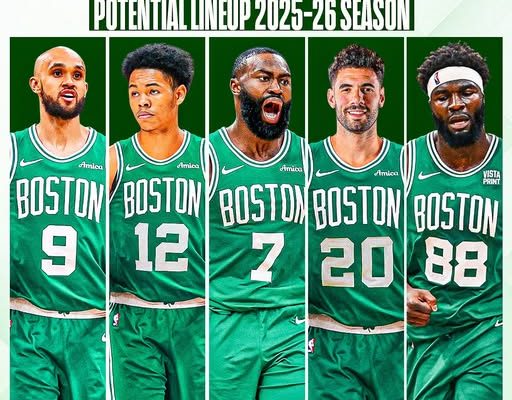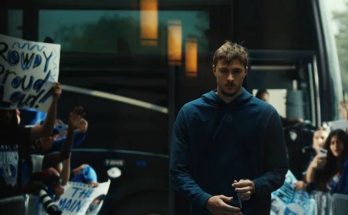The Boston Celtics are entering the 2025-26 NBA season with a clear mission: reclaim their seat atop the NBA throne and redefine the blueprint for sustained excellence. After winning the 2024 NBA Championship and coming within a game of repeating in 2025, the Celtics’ leadership—both on and off the floor—has evolved, reshaped, and reenergized in ways that now place Jaylen Brown front and center. The once “second option” has transformed himself not only into a consistent elite performer but also into the emotional and vocal anchor of the team. As the franchise undergoes a subtle reboot, it’s not about tearing down and rebuilding. Instead, it’s a strategic recalibration around a hardened core of Brown, Derrick White, and an emerging cadre of talent that includes younger assets and role players who now carry larger responsibilities.
Jaylen Brown’s leadership has shifted the tone of the Celtics’ locker room. For years, Jayson Tatum was viewed as the face of the franchise, but as dynamics changed, injuries took their toll, and external trade rumors swirled, it was Brown who stood unwavering. His performance in the 2025 playoffs was a defining moment. Not only did he deliver big on the scoreboard, but he also refused to be rattled when the Celtics faced elimination against a surging Milwaukee Bucks team led by Giannis Antetokounmpo and Tyrese Maxey. Brown’s calm demeanor, his fiery play, and his choice words in huddles during crucial Game 6 and 7 moments reinforced what many within the Celtics’ organization already believed: Brown is not just a co-star. He’s the heartbeat of this team now.
The front office, led by Brad Stevens, has made calculated moves to support this transition in leadership. Though Jayson Tatum is still on the roster, his recurring injuries, including a lingering foot issue that limited his availability late last season, have forced the Celtics to plan around less certainty from their previous go-to guy. It was no coincidence that the Celtics declined to offer Tatum a max extension this summer, at least not immediately. Instead, Stevens and the ownership group have pivoted their strategy to ensure roster flexibility while prioritizing durability, chemistry, and hunger. They shipped out aging veterans who couldn’t stay healthy when it mattered and brought in gritty contributors like Jordan Goodwin and Ron Holland, while also signing undrafted standout Jalen Wilson to a multi-year deal after a stellar G-League campaign. This roster isn’t glitzy—but it’s deep, athletic, and coach Joe Mazzulla has already praised the group’s adaptability during early practices.
It’s a reboot, but not a rebuild. And there’s a crucial difference. The Celtics aren’t blowing things up. Instead, they’re re-centering the ship on Brown’s leadership and shifting expectations for players like Sam Hauser, Payton Pritchard, and even veterans like Al Horford and Kristaps Porziņģis, who are now being used more strategically than ever. Horford, whose minutes will be reduced for regular-season preservation, is expected to play the role of mentor-coach hybrid for the team’s younger frontcourt. Porziņģis, who missed much of last year’s playoff run due to a fractured fibula, has returned healthy and motivated, but no longer shoulders the same expectations to be a nightly 25-point scorer. Instead, the coaching staff will stagger his minutes with younger, more agile defenders to better preserve his body for when the team needs him most: April and beyond.
Joe Mazzulla enters his third full season as head coach, and while he’s often criticized for being analytically rigid or too system-driven, he has evolved. After a bumpy first campaign, he’s found a balance between embracing numbers and trusting his gut. Players have noticed the difference, particularly Jaylen Brown. There’s a mutual respect now that didn’t fully exist before. Brown isn’t just the locker room voice—he’s Mazzulla’s co-pilot in real-time decisions. During their preseason training camp in Maine, Brown and Mazzulla were seen having long one-on-one walks, discussing rotations, player matchups, and late-game execution. The Celtics are more unified now than they’ve been in years, and that cohesion starts at the top.
Another central storyline revolves around how the Celtics plan to handle Tatum’s future. He is still, without question, a top-tier talent when healthy. But his durability issues have opened the door for speculation. Some insiders suggest the Celtics may explore trade options if Tatum cannot stay consistently on the floor this season. One Western Conference executive even mentioned that Boston quietly inquired about the availability of Brandon Ingram in a potential Tatum swap. Though no deal is imminent, the fact that such discussions are even being entertained illustrates how dramatically the franchise’s internal calculus has shifted. Brown is not just an insurance plan anymore—he is the plan. And Tatum, once seen as untouchable, may be approaching a crossroads in Boston.
Defensively, the Celtics remain elite. Anchored by Derrick White—who has arguably become one of the most impactful two-way guards in the NBA—the team is re-establishing its identity on that end of the floor. White’s instincts, shot contest numbers, and pick-and-roll navigation have become textbook examples for younger Celtics like JD Davison and Ron Holland, who’ve praised White for mentoring them off the floor as well. Boston’s defensive scheme is more switchable than it’s been in recent years, with lineups that now feature three wings with 6’7” or taller frames, allowing for more fluid coverage and less need for traditional drop-back bigs. Robert Williams III, long known as the team’s vertical anchor, has been moved in limited spurts to more perimeter coverage drills, further expanding the team’s defensive versatility.
The offensive game plan is also undergoing subtle changes. Brown is expected to bring the ball up more frequently this year, especially when opposing teams send traps or blitzes at the point. While Brown struggled with turnovers early in his career when asked to handle those duties, he’s drastically improved. In the final 15 games of last season, Brown averaged under two turnovers per game while increasing his usage rate. That’s a trend the Celtics want to lean into. Mazzulla has also implemented more off-ball motion sets, capitalizing on Hauser’s quick release and Pritchard’s knack for relocating after a kick-out. The Celtics’ offense won’t rely on isolation plays nearly as much as it did in 2023 or 2024. Instead, they’re embracing a Warriors-lite system of constant movement, spacing, and unselfish decision-making. The goal is simple: make defenses guess on every possession, and wear down star defenders through perpetual screen navigation.
All eyes, though, remain on the Eastern Conference landscape. The Milwaukee Bucks, with a fully healthy Giannis and Khris Middleton, remain a threat. So too do the Cleveland Cavaliers, who just added veteran scorer Tobias Harris to complement Donovan Mitchell and Evan Mobley. The Miami Heat, though aging, still have Jimmy Butler and Erik Spoelstra’s playoff wizardry. But Boston believes their best weapon is continuity. They’re not chasing flashy names anymore—they’re perfecting the puzzle they already possess. Brown, White, Porziņģis, Horford, and Hauser represent a group that understands their roles, trusts each other, and—perhaps most importantly—has lived through enough postseason heartache to know exactly what winning requires.
There’s also an emotional undercurrent to this reboot. Brown, who has long spoken about his off-court interests in social justice and education reform, has become more vocal about his desire to use his platform not just for basketball, but for leadership in Boston as a whole. He’s been seen more frequently around local schools, has hosted town hall meetings, and has even discussed investing in Boston-based tech startups. His voice now carries the weight of someone invested in legacy—not just stats. That kind of perspective has rubbed off on teammates. Players like Pritchard and Davison have credited Brown for making the team more cohesive, more thoughtful, and more driven.
So, while the 2025-26 season begins with the typical uncertainty that defines every NBA year—injuries, trades, streaks, and collapses—the Boston Celtics enter this campaign with clarity. They are not the same team that hoisted the trophy two seasons ago. They’re something different—leaner, more mature, and led by a man who was once overlooked in conversations about NBA leadership. Jaylen Brown has earned the keys to the franchise not through demands, but through delivery. His consistent two-way excellence, evolving playmaking, and galvanizing presence have made him the soul of the Celtics.
If everything breaks right, the Celtics won’t just be chasing another banner. They’ll be establishing a new model for how to transition from one era to another without fracturing the identity that made them great in the first place. The reboot is already underway—not with loud declarations or blockbuster trades, but with subtle, strategic, and powerful shifts in who the Celtics are and who they believe they can become. In the end, it may not be just about raising another championship banner. It might be about proving that evolution, when guided by loyalty and grit, is a winning formula on its own.



